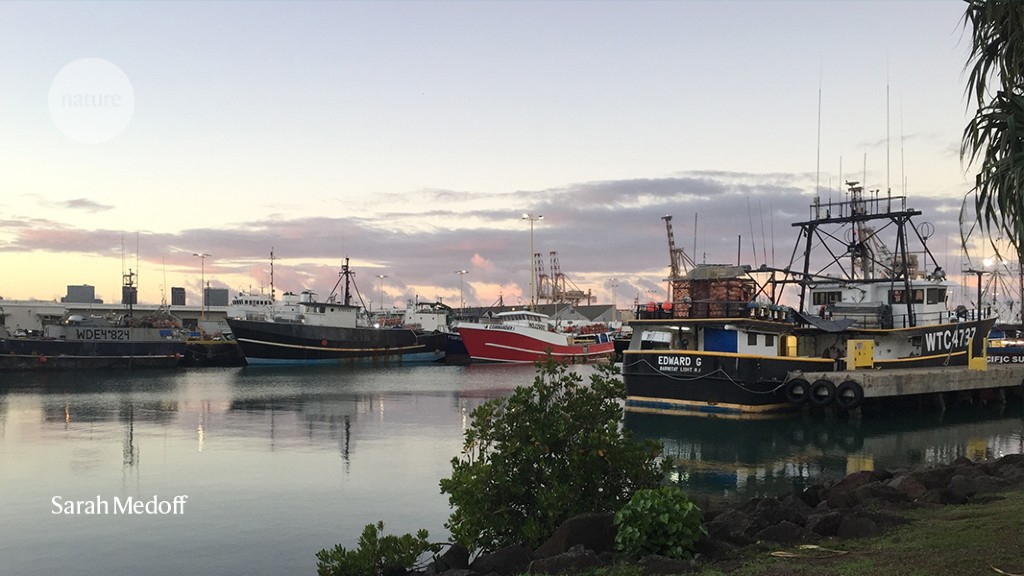Tuna catch rates rose after the creation of a no-fishing zone in Hawaii
Longline fishing boats like this one in Honolulu Harbor in Hawaii must respect a large no-fishing zone off the west side of the archipelago.Credit: Sarah Medoff
According to a study, large areas with no fishing can drive the recovery of commercially valuable fish species. A decade of fisheries data has shown catch rates of two important tuna species have increased dramatically near a marine reserve surrounding the northwestern Hawaiian Islands.
“It’s a win-win for fish and fishermen,” says Jennifer Raynor, an economist at the University of Wisconsin-Madison and co-author of the study, published Oct. 20 in Science1.
The findings underscore the value of large marine protected areas — a style of environmental management that has emerged primarily in the Pacific Ocean over the past two decades, says Kekuewa Kikiloi, who studies Hawaiian culture at the University of Hawaii at Mānoa. Countries around the world have pledged to protect 30% of their land and oceans by 2030.
Previous research has shown that marine protected areas can help restore populations of creatures like coral that don’t move much or at all2 and lobster3. Raynor and her colleagues wanted to test whether the areas could also drive recovery for migratory species and provide spillover benefits for fisheries. Researchers surveyed one of the largest such areas in the world, the 1.5 million square kilometer Papahānaumokuākea Marine National Monument, created in 2006 and expanded in 2016 to protect biological and cultural resources.
The team focused on the Hawaiian deep-sea longline fishery primarily targeting yellowfin tuna (Thunnus albacares) and bigeye tuna (Thunnus obesus).
Researchers analyzed catch data collected on fishing vessels between 2010 and late 2019. They then compared catch rates at various distances up to 600 nautical miles (1,111 kilometers) from the sanctuary before and after its expansion in 2016. (The sanctuary itself currently extends 200 nautical miles from the northwest portion of the Hawaiian archipelago.) They found that post-expansion catch rates – defined as the number of fish caught per 1,000 hooks deployed – increased and that the increases were larger the closer boats were to the no-fishing zone. At ranges of up to 100 nautical miles, catch rates for yellowfin tuna increased by 54% and for bigeye tuna by 12%. Some other types of catch quotas also increased, but not in the same way.
The size of Papahānaumokuākea Marine National Monument — more than three times the area of California — likely contributed to the positive effects as much as its shape. It stretches about 2,000 kilometers from west to east and protects large parts of the ocean waters in tropical latitudes. This means that tropical fish like yellowfin tuna and bigeye tuna — which tend to move along an east-west axis to stay in their preferred temperature range — can travel a long distance and still remain in the no-fishing zone.
Additionally, Raynor says, Papahānaumokuākea is a spawning ground for yellowfin tuna. Because the animals are not far from their birthplace, the no-fishing zone provides sanctuary from fishing and helps tuna to congregate and reproduce.
“It’s exciting to see that this marine sanctuary has benefits for the fishing industry,” says David Kroodsma, director of research and innovation at Global Fishing Watch in Oakland, California, a US nongovernmental organization that monitors fishing activities worldwide. However, he adds, it is unclear whether the results can be extrapolated to other regions of the world.
Regardless, the findings could help others design marine protected areas to benefit fisheries, says Steve Gaines, a marine ecologist at the University of California, Santa Barbara. The study, he says, “provides a platform to definitively assess what works and what doesn’t.”
Managed jointly by indigenous peoples, the state of Hawaii and the US government, Papahānaumokuākea is an example of a collaborative management strategy that combines indigenous knowledge and modern science, says Kikiloi. The approach, he adds, “can work successfully elsewhere if you give it a chance.”


Comments are closed.